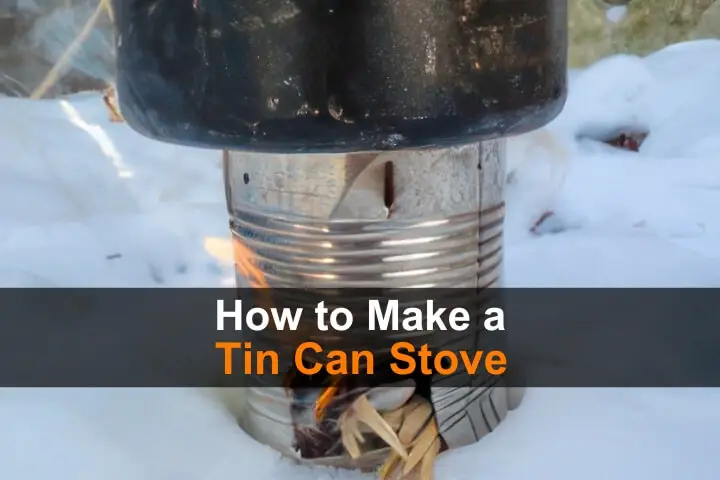Estimated reading time: 8 minutes

Even if you’re not in a survival situation, knowing how to make a tin can stove is still an useful skill to have. Perfect for boiling water or whipping up a simple meal, this lightweight, efficient tool offers functionality without requiring expensive materials or tedious assembly.
Best of all, it’s something you can create from items you likely already have at home or items that can be easily scavenged outside.
Want to save this post for later? Click Here to Pin It On Pinterest!
What Is a Tin Can Stove?

A tin can stove is a compact, DIY cooking tool built from an empty tin can. Because of its simplicity and versatility, it’s a popular solution for outdoor enthusiasts, survivalists, and anyone tackling basic preparedness projects.
Crafted with just a few holes and an opening for fuel, the stove channels airflow efficiently, allowing a small flame to burn hot enough to cook food or boil water.
Unlike larger camping stoves or equipment requiring fuel canisters, tin can stoves have the unique advantage of using natural materials like small sticks or cardboard as fuel. They provide a lightweight, low-cost alternative to commercial stoves, which some people will use on their camping trips for simple cooking.

To get started, you’ll need a handful of basic materials and some tools. The can may be sharp to handle, so if you want to avoid injury, wear some cut-resistant gloves.
Materials:
- A large tin can (e.g., from canned vegetables or juice)
- Thin sticks, twigs, cardboard, or other natural flammable material for fuel
- Matches or a lighter to ignite the stove
Tools:
- Tin snips, tough scissors, or a sharp utility knife
- A pocket can opener (or any handheld can opener for punching holes)
- Work gloves (highly recommended for handling sharp edges)
Choose the size of the tin can based on your cooking needs. Larger cans can hold more fuel, making them ideal for extended burns or larger meals. Smaller cans are more portable but may need refueling more often.

Step-by-Step Guide to Building Your Tin Can Stove
Now that you’ve gathered your materials, it’s time to build your stove. The steps are relatively simple, and you should have your stove up and running in 10 minutes or less.
Step 1: Preparing the Tin Can
Start by removing any labels and adhesive from your can. Labels can catch fire and produce harmful fumes, so it’s essential to work with a clean exterior.

Inspect the can to ensure it’s intact and has a sturdy bottom to support fuel and your cooking vessel. If the can is missing its bottom, don’t worry—a tin can stove can still be built. At that point, you’ll burn the fuel on the ground.

Step 2: Cutting the Fuel Opening
Using your knife, carefully cut a rectangular opening on the bottom side of the can. This opening will serve as the insertion point for your fuel. Aim for an opening that is just large enough to fit small sticks, twigs, or rolled cardboard.

After the opening is cut, fold the cut flap inwards, it should rest on the bottom lid of the can on the inside.

Step 3: Adding Ventilation Holes
Airflow is critical for keeping the fire burning efficiently. To achieve this, use your pocket can opener to punch small, evenly spaced holes in paired sets around the base of the can. This allows oxygen to flow in and feed the fire.

Next, add four single ventilation holes along the top rim of the can. These prevent your pot, pan, or kettle from smothering the flame while cooking. The holes also help release heat, aiding the combustion process.

How to Use Your Tin Can Stove
Lightweight, functional, and easy to assemble, your tin can stove is ready to tackle its first use! Here’s how to make the most of it.

1. Load the Fuel: Begin by loosely stacking small sticks, twigs, or dry cardboard into the fuel opening at the bottom of the can.

For easy lighting, place a few pieces of crumpled paper or dry leaves close to the opening.

2. Ignite: Carefully light the paper or leaves using a lighter or matches. This base layer of tinder helps ignite the larger pieces of fuel above it.

3. Monitor the Flame: Add small sticks gradually as the initial fire catches, ensuring the flame stays consistent and hot. Many small, dry sticks will burn hotter and faster than a single large piece of wood.

4. Start Cooking: Once the flame is steady, position your pot or pan on top of the can. Keep an eye on the fire and add fuel every time you feel the heat is diminishing.

Final Thoughts
A tin can stove is one of those tools that showcases ingenuity, affordability, and practicality rolled into one DIY project.

While not a long-term solution, it is capable of lasting several burns before showing wear. Since you can find old cans nearly everywhere in the world it’s one of the best options for anyone needing a stove in a pinch.
Like this post? Don’t Forget to Pin It On Pinterest!
You May Also Like:
Read the full article here




